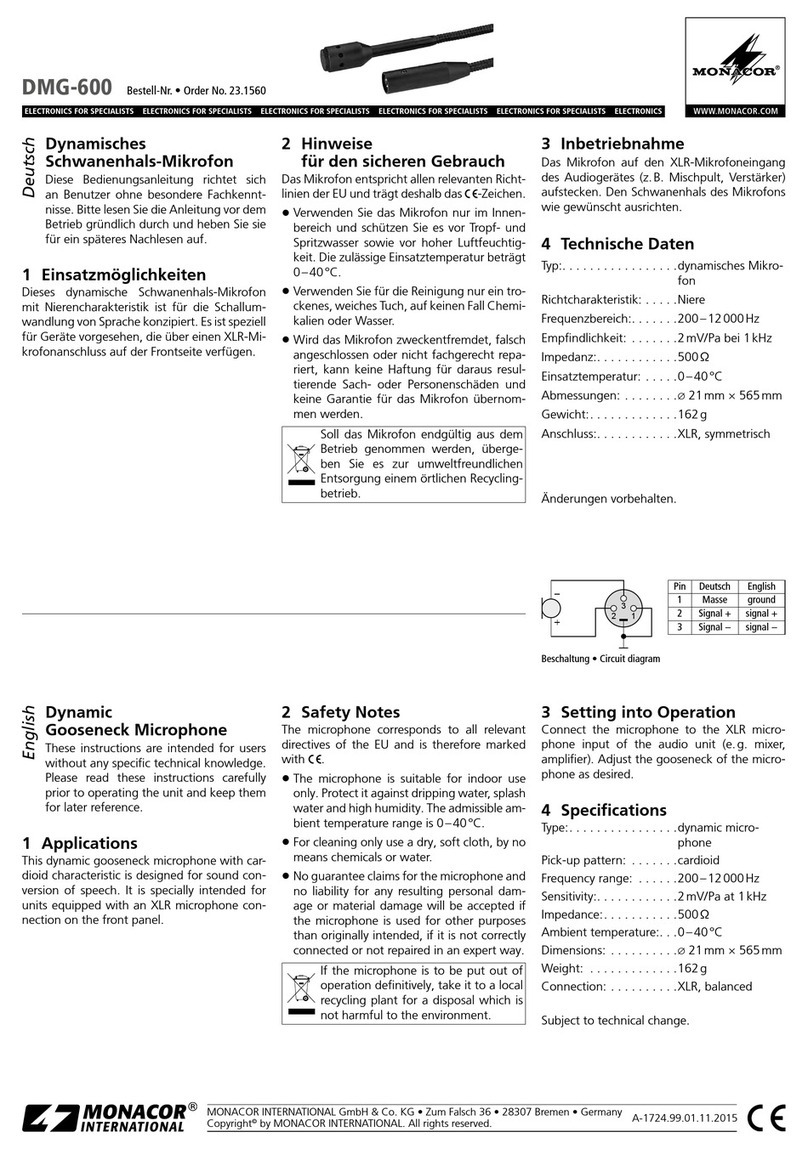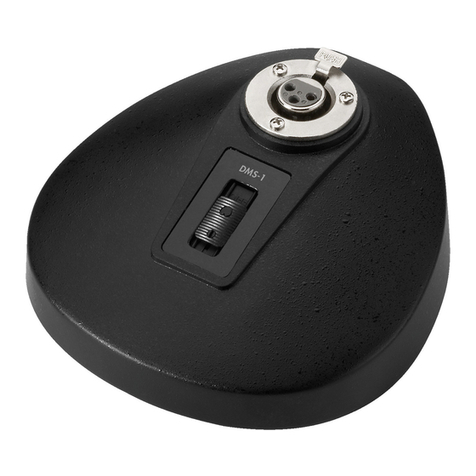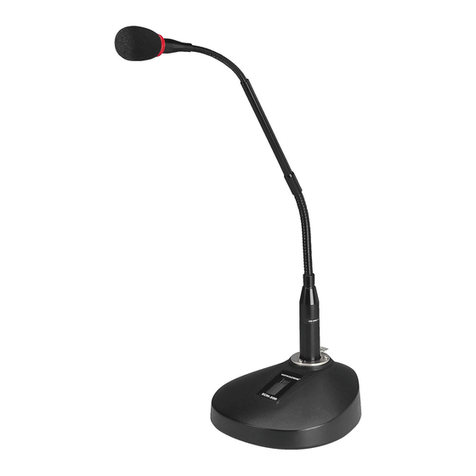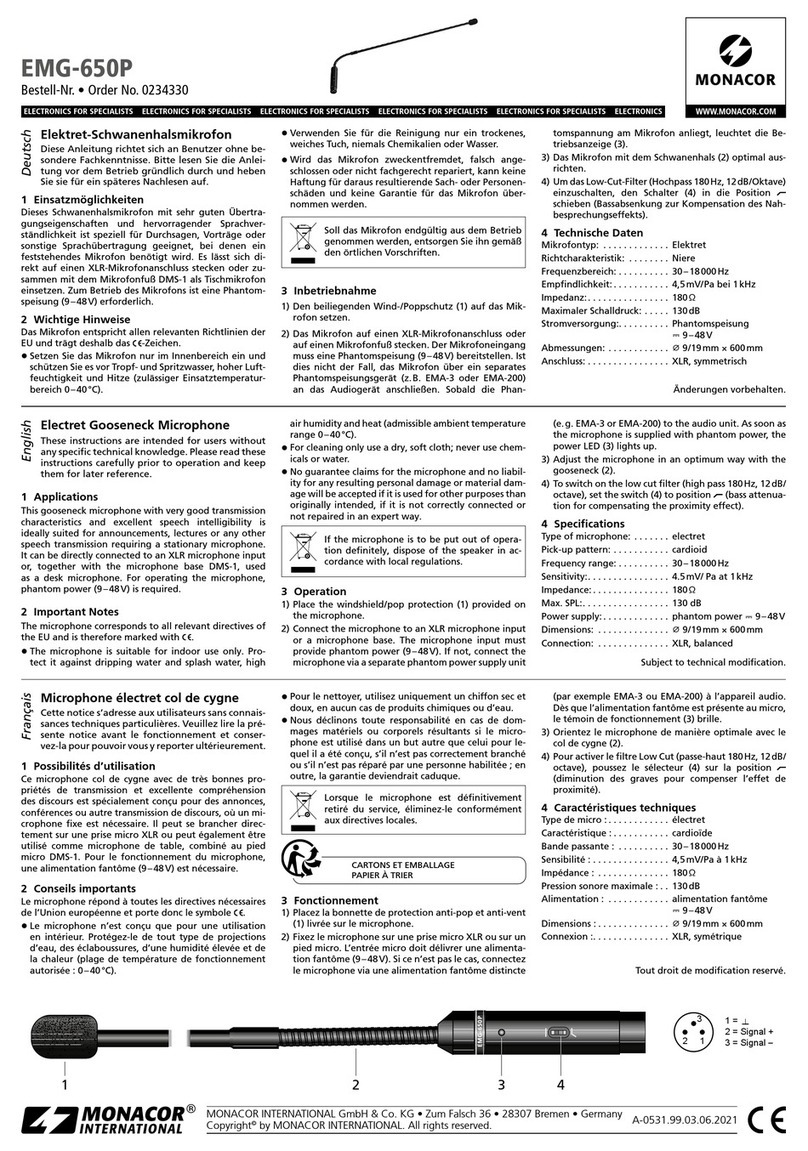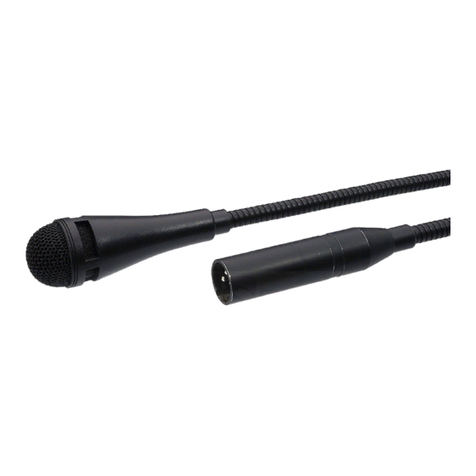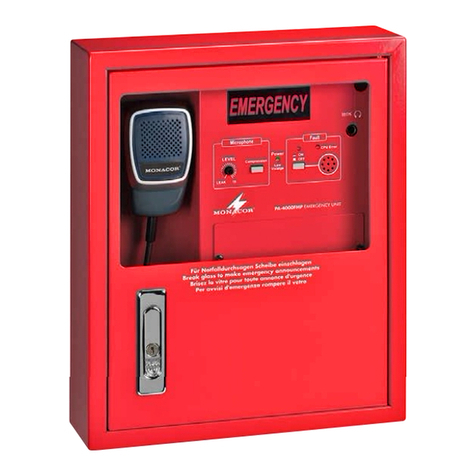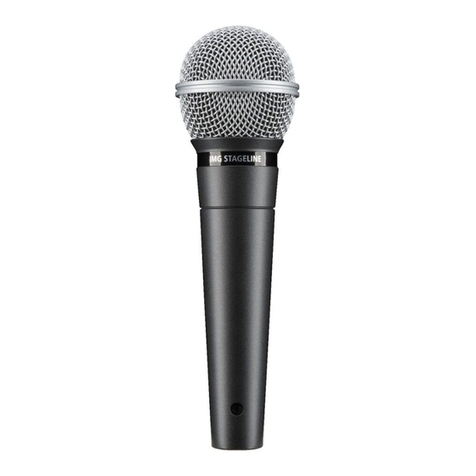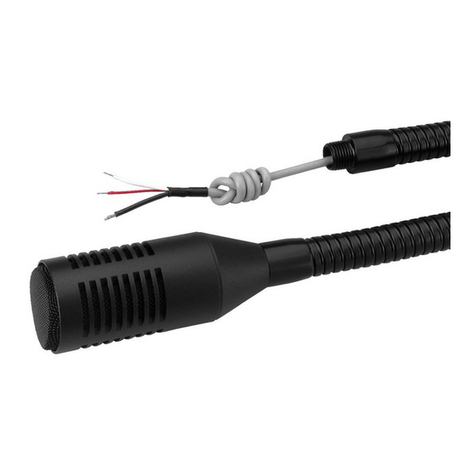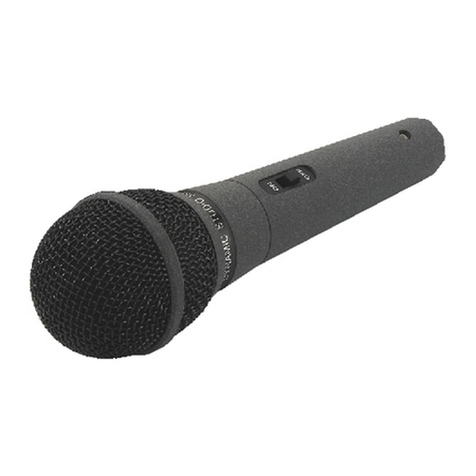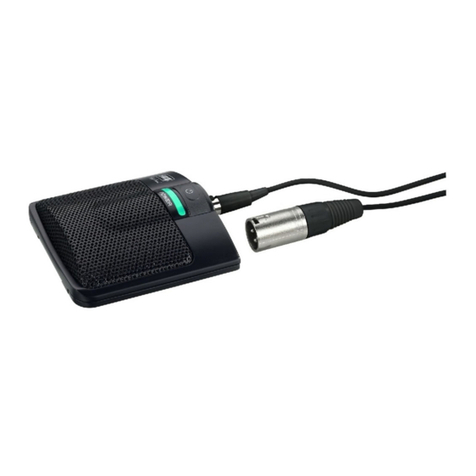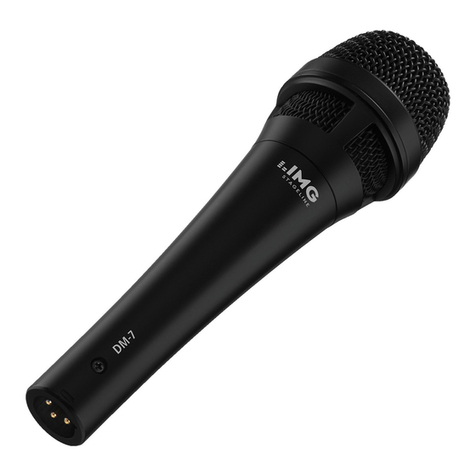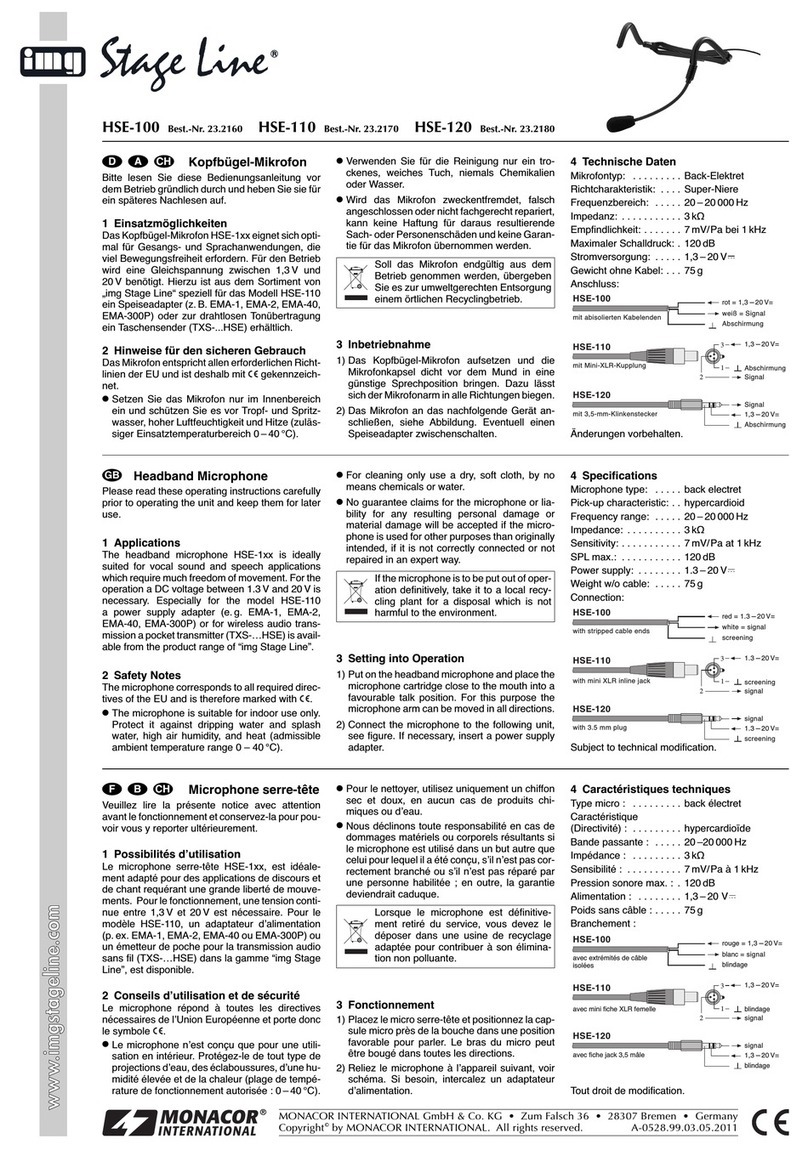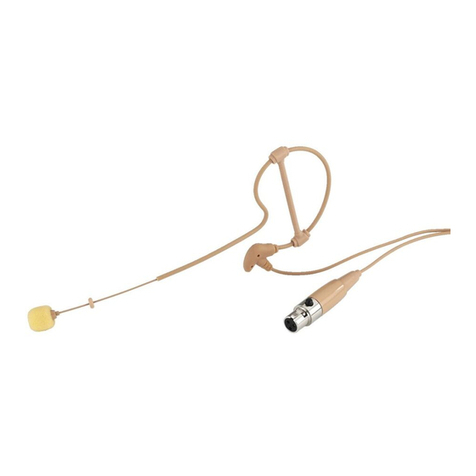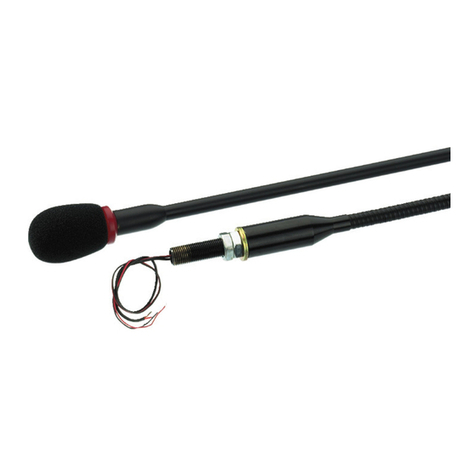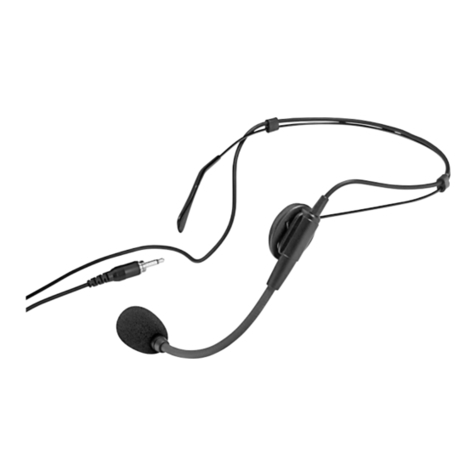Micrófono de mano con emisor
multifrecuencia
Por favor, lea estas instrucciones de uso atentamente
antes de utilizar la unidad y consérvelas para usos poste-
riores.
1 Aplicaciones
Este micrófono de mano con emisor multifrecuencia PLL
sirve para la transmisión inalámbrica de habla/canto
hacia un receptor. Se puede ajustar en 16 canales en la
gama UHF de 863 – 865 MHz y es ideal para combinar
con los sistemas amplificadores portátiles TXA-110 y
TXA-120 de MONACOR porque las partes receptoras de
estos sistemas están sintonizadas de manera precisa en
las frecuencias del micrófono.
1.1 Conformidad y aprobación
Por la presente, MONACOR INTERNACIONAL declara
que el micrófono inalámbrico TXA-100HT es acorde a los
requisitos básicos y a las demás regulaciones pertinentes
de la directiva 1999/5/EC. El micrófono inalámbrico no
necesita licencia y ha sido aprobado de manera general
para su uso en la UE y los países de la AELC.
2 Notas importantes
El micrófono corresponde a todas las Directivas requeri-
das por la UE y por ello está marcado con .
GEl micrófono sólo está indicado para su uso en interior.
Protéjalo contra las salpicaduras, los goteos de agua,
la humedad elevada del aire, y el calor (gama de tem-
peratura ambiente admisible 0 – 40 °C).
GPara la limpieza utilice sólo un paño seco y suave, no
use nunca productos químicos o agua.
GSi no se usa el micrófono durante un largo periodo,
saque las pilas para prevenir cualquier daño en el
micrófono debido a pérdidas de las pilas.
GNo se aceptará ninguna reclamación de garantía para
el micrófono en caso de daños personales o patrimo-
niales si se usa el micrófono para otros fines distintos
de los originalmente concebidos, si no se utiliza correc-
tamente, o si no se repara de manera experta.
3 Puesta en funcionamiento del micrófono
1) Desenrosque la tapa (5) del micrófono. El comparti-
miento para las pilas (1) y el interruptor de canal (2)
ahora quedarán accesibles.
2) Inserte 2 pilas de 1,5 V de tipo AA con los polos positi-
vo y negativo como está impreso en el compartimiento
para las pilas.
3) Antes de encender el micrófono, ajuste el receptor
correspondiente en un canal de transmisión libre de
interferencias.
4) Ajuste el micrófono en el mismo canal con el interrup-
tor giratorio (2).
5) Atornille la tapa (5) de nuevo en el micrófono.
6) Encienda el micrófono con el interruptor corredero (4)
[posición ON]. El LED de pila (3) se muestra en verde.
Si se muestra en rojo tras el encendido o durante el
Si el micrófono debe retirarse definitivamente
del funcionamiento, llévelo a una planta de reci-
claje local para su disposición no perjudicial
para el medio ambiente.
Las pilas gastadas/pilas recargables defectuosas no
pertenecen a la basura doméstica, llévelas siempre a un
contenedor especial de residuos (p. ej. un container
colector en su distribuidor).
TXA-100HT Best.-Nr. 17.2450
funcionamiento, las pilas insertadas están casi gasta-
das y deben ser remplazadas.
7) Tras el funcionamiento, ajuste el interruptor corredero
(4) en OFF para apagar el micrófono.
4 Características técnicas
Tipo de unidad: . . . . . . . . . micrófono de mano dinámi-
co con PLL emisor multifre-
quencia
Características de captación: cardioide
Gama de frecuencia radio: 863 – 865 MHz,
dividida en 16 canales
Potencia de transmisión: . . < 10 mW (EIRP)
Estabilidad de frecuencia: . ±0,005 %
Gama de frecuencia audio: 50 – 18 000 Hz
Temperatura ambiente: . . . 0 – 40 °C
Alimentación: . . . . . . . . . . . dos 1,5 V pilas tipo AA
Dimensiones, peso: . . . . . . ∅50 mm × 255 mm, 290 g
Sujeto a modificaciones técnicas.
1234 5
Mikrofon ręczny z nadajnikiem
wielozakresowym
Przed użyciem urządzenia należy przeczytać instrukcję
obsługi i zachować ją do wglądu.
1 Zastosowanie
Dynamiczny mikrofon ręczny z nadajnikiem wieloza-
kresowym PLL służy do bezprzewodowej transmisji
mowy / wokalu do odbiornika. Dostępnych jest 16 kanałów
w paśmie UHF 863 – 865 MHz. Mikrofon oraz nadajnik są
przystosowane do współpracy z przenośnym systemem
wzmacniającym TXA-110 oraz TXA-120 firmy MONACOR
– odbiorniki systemów są nastawione na częstotliwości
mikrofonu.
1.1 Normy i zezwolenia
Niniejszym firma MONACOR INTERNATIONAL oświad-
cza, że mikrofon bezprzewodowy TXA-100HT spełnia
wymogi dyrektywy 1999 / 5 / EC i jest zgodny z zawartymi
w niej przepisami. Mikrofon bezprzewodowy nie wymaga
zezwolenia i został dopuszczony do użytkowania w kra-
jach należących do Unii Europejskiej oraz Europejskiego
Stowarzyszenia Wolnego Handlu (EFTA).
2 Bezpieczeństwo użytkowania
Mikrofon spełnia wymogi norm obowiązujących w Unii
Europejskiej, posiada więc oznaczenie .
GUrządzenie przeznaczone jest do użytku jedynie w
pomieszczeniach. Należy chronić je przed działaniem
wilgoci oraz wysokiej temperatury (zakres dopuszczal-
nej temperatury otoczenia pracy: 0 – 40 °C).
GDo czyszczenia urządzenia należy używać suchej,
miękkiej tkaniny. Nie wolno stosować wody ani che-
micznych środków czyszczących.
GJeśli mikrofon nie będzie używany przez dłuższy czas,
należy wyjąć baterie. W razie wycieku baterii urządze-
nie nie ulegnie uszkodzeniu.
GProducent ani dostawca nie ponoszą odpowiedzialno-
ści za wynikłe szkody (uszkodzenie sprzętu lub obra-
żenia użytkownika), jeśli urządzenie używano niezgod-
nie z przeznaczeniem, nieprawidłowo obsługiwano
bądź poddano nieautoryzowanej naprawie.
3 Przygotowanie urządzenia do pracy
1) Należy odkręcić pokrywę (5) mikrofonu, aby uzyskać
dostęp do komory na baterie (1) oraz przełącznika
kanałów (2).
2) W komorze należy umieścić dwie baterie 1,5 V AA, z
zachowaniem odpowiedniej biegunowości, zgodnie z
nadrukiem w komorze.
3) Przed włączeniem mikrofonu, na odbiorniku należy
ustawić kanał transmisyjny wolny od zakłóceń.
4) Za pomocą przełącznika kanałów (2) należy ustawić
ten sam kanał dla mikrofonu.
5) Należy przykręcić pokrywę (5).
6) Za pomocą przełącznika (4) należy włączyć mikrofon
(pozycja ON). Wskaźnik stanu naładowania baterii (3)
zaświeci się na zielono. Jeśli wskaźnik będzie się świe-
cić na czerwono po włączeniu mikrofonu lub podczas
Po całkowitym zakończeniu eksploatacji urzą-
dzenia należy przekazać je do punktu utylizacji
odpadów, aby uniknąć zanieczyszczenia środo-
wiska.
Zużyte lub uszkodzone baterie/akumulatory należy
przekazać do punktu utylizacji odpadów lub wyrzucić do
specjalnego kontenera w sklepie z artykułami elektrycz-
nymi (baterie można też zwrócić producentowi).
jego pracy, oznacza to niski stan naładowania baterii –
należy je wówczas wymienić.
7) Po zakończeniu obsługi należy wyłączyć mikrofon za
pomocą przełącznika (4) [pozycja OFF].
4 Dane techniczne
Rodzaj urządzenia: . . . . . . . . dynamiczny mikrofon
ręczny z nadajnikiem
wielozakresowym PLL
Charakterystyka: . . . . . . . . . . kardioidalna
Zakres częstotliwości radiowej: 863 – 865 MHz,
podział na 16 kanałów
Moc nadajnika: . . . . . . . . . . . <10 mW (EIRP)
Stabilność częstotliwości: . . . ±0,005 %
Zakres częstotliwości
akustycznej: . . . . . . . . . . . . . . 50 – 18 000 Hz
Temperatura otoczenia pracy: 0 – 40 °C
Zasilanie: . . . . . . . . . . . . . . . . 2 × bateria 1,5 V, AA
Wymiary, waga: . . . . . . . . . . . ∅50 mm × 255 mm, 290 g
Z zastrzeżeniem możliwości zmian.
MONACOR INTERNATIONAL GmbH & Co. KG • Zum Falsch 36 • 28307 Bremen • Germany
Copyright©by MONACOR INTERNATIONAL. All rights reserved. A-0761.99.02.06.2011
®
E
PL
4
6
Asignación de canal
863,425 MHz
1
863,675 MHz
3
5 863,550 MHz
12
14
7 863,800 MHz
13
15
863,050 MHz
863,300 MHz
8
9
11
16
10
864,425 MHz
2
864,675 MHz
863,925 MHz
864,550 MHz
863,175 MHz
864,800 MHz
864,050 MHz
864,300 MHz
864,925 MHz
864,175 MHz
Canal CanalFrecuencia de transmisión Frecuencia de transmisión
4
6
Przyporządkowanie kanałów
863,425 MHz
1
863,675 MHz
3
5 863,550 MHz
12
14
7 863,800 MHz
13
15
863,050 MHz
863,300 MHz
8
9
11
16
10
864,425 MHz
2
864,675 MHz
863,925 MHz
864,550 MHz
863,175 MHz
864,800 MHz
864,050 MHz
864,300 MHz
864,925 MHz
864,175 MHz
Kanał Kanał Częstotliwość nadawczaCzęstotliwość nadawcza
